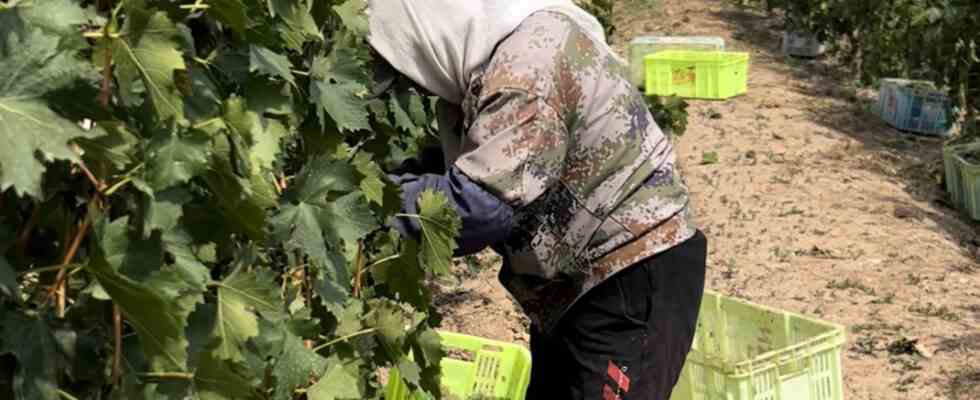report
Status: 09/26/2022 12:38 p.m
Chinese love wine. In the meantime, even more and more wine is being grown in the country itself. In the Ningxia part of the country, a wine region has arisen from nothing. But the Riesling is expensive.
Grape harvest in the Ningxia district. The barren Helan Mountains can be seen in the background. Shortly before noon the sun is high in the sky, it is 30 degrees hot. Where there used to be barren, rocky land, workers now kneel on the ground and use scissors to carefully cut the ripe grapes from the vines and place them in baskets. The grapes are plump and taste sweet.
100,000 bottles of wine a year
Today, Riesling is harvested on Wang Fang’s 70-hectare vineyard. The approximately 50-year-old founded her winery called Kanaan ten years ago with seed capital from her father, who has been running a winery nearby for some time. She now produces up to 100,000 bottles of wine a year, she says: Merlot, Cabernet Sauvignon and Riesling.
Wang Fang also speaks German, but would prefer to speak in English because she feels safer, she says. After living in Germany for ten years, she decided to grow Riesling in Ningxia. But it is actually much too hot here for the German grape variety. And the Chinese drink almost exclusively red wine.
“Riesling from the Gobi desert?”
But that didn’t deter Wang Fang: “It’s like a revolution in this area. People call me Crazy Fang. One reason is certainly that I grow Riesling here without having any experience with it. That has mine too Friends in Germany surprised. Are you completely crazy? Riesling from the Gobi desert?”
Viticulture in the area brings with it great challenges. The growth period is comparatively short, from mid-April to September, when the harvest begins. Because it is so dry and hot in summer in the Ningxia region, the vines have to be watered. The water comes from the Yellow River, which flows very close by.
And because it is so cold in winter – down to minus 25 degrees – the vines have to be tied to the ground and completely covered with earth every autumn. Otherwise the vines would freeze. They are then dug up again in the spring.
Wang Fang grows Riesling – without any experience in viticulture.
A bottle for 30 euros
The whole procedure is extremely laborious and drives up the cost of wine from the Ningxia region. The cheapest bottle of Riesling from Wang Fang costs the equivalent of just over 30 euros. You can even get a drinkable German Riesling cheaper in China, despite the high import taxes.
Another reason why good wine from China is expensive is the high investment costs. Almost all equipment for cultivation has to be imported from abroad. In addition, the cultivation areas have to be rented from the state, explains Wang Fang.
Despite the comparatively high prices for Chinese wine, insiders reveal that numerous wineries in the area are making losses, even if few winegrowers like to talk openly about it.
Wine fair in Ningxia: The Chinese part of the country has experienced a veritable wine boom in recent years.
Wine goes to hotels or restaurants
The Chinese Riesling winemaker Wang Fang gives a tour of her house. She brought a lot of furniture and paintings with her from Germany, and the inside of her house is reminiscent of a German country house. She proudly talks about the international awards her wines have won.
Most of their bottles go to Chinese hotels and restaurants or are served at events. But she also has customers who order individually and who already export abroad – and would like to do this even more in the future.
“Why should people buy Chinese Riesling? If you are a wine lover, you must taste Chinese Riesling. You must taste different Riesling from different parts of the world. Why not Chinese? Chinese Riesling is my Riesling.”
Chinese Riesling from the edge of the desert
Benjamin Eyssel, ARD Beijing, September 26, 2022 11:09 a.m

